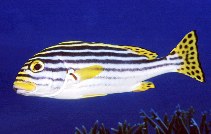Plectorhinchus vittatus (Linnaeus, 1758)
Indian Ocean oriental sweetlips |
|
Oriental sweetlips,
Alatan,
Bakoko,
Gabilan,
Goliabao,
Gulyabau,
Isdang sabato,
Kayubibi,
Kiskisan,
Labian,
Lifte,
Lipti,
Nabilan,
Panirachirawan,
Pasingko,
Samaral,
Sidingan,
Silay
|
| Family: |
Haemulidae (Grunts), subfamily: Plectorhinchinae |
| Max. size: |
72 cm SL (male/unsexed) |
| Environment: |
reef-associated; marine; depth range 2 - 25 m |
| Distribution: |
Indo-West Pacific: East Africa (Ref. 33390) to western Indian Ocean to Papua New Guinea and New Caledonia. |
| Diagnosis: |
Dorsal spines (total): 12-14; Dorsal soft rays (total): 17-20; Anal spines: 3-3; Anal soft rays: 7-8. This species is distinguished by the following characters: chin with 6 pores, no median pit; gill rakers on first gill arch 9-11 + 1 + 20-23 = 29-34; Dorsal fin with XII-XIV (usually XIII),17-20 with 3rd or 4th spines longest; lips fleshy, greatly swollen with age; scales ctenoid (rough to touch); lateral line tubed scales about 55-65; body depth 2.6-2.9 in SL; caudal fin rounded in juveniles, truncate in adults. Colour: juveniles with connected black blotches and spots that gradually break up into horizontal stripes; pectoral fins black in juveniles becoming uniform yellow in adults; tail spotted with age; adults with 6 to 12 broad dark brown, blue-brown or black stripes that persist on the belly and join horizontally across the nape and snout with anterior part of pale interspaces yellow forming 2 bright yellow stripes across interorbital and 2 around snout; eye usually yellow; fins yellow with black margins to vertical fins and black spots, pectoral fins uniform yellow with red-brown, chocolate, or blackish base, pelvic fins yellow with base red-brown, scarlet, or dark brown (Ref. 47695, 90102). |
| Biology: |
Inhabits coral reefs and inshore rocky reefs (Ref. 30573). Juveniles solitary, inhabits clear shallow protected lagoon; adults may be solitary or occur in aggregations (Ref. 37816). by handline and spear. Marketed fresh, a small quantity is salted (Ref. 47695). |
| IUCN Red List Status: |
Least Concern (LC); Date assessed: 28 June 2018 Ref. (130435)
|
| Threat to humans: |
harmless |
| Country info: |
Known from Prieto Diaz, Sorsogon (Ref. 58652). Most common sweetlip in Luzon (Ref. 13724). Also Ref. 1602, 48613, 53416, 121724. |
Source and more info: www.fishbase.org. For personal, classroom, and other internal use only. Not for publication.

